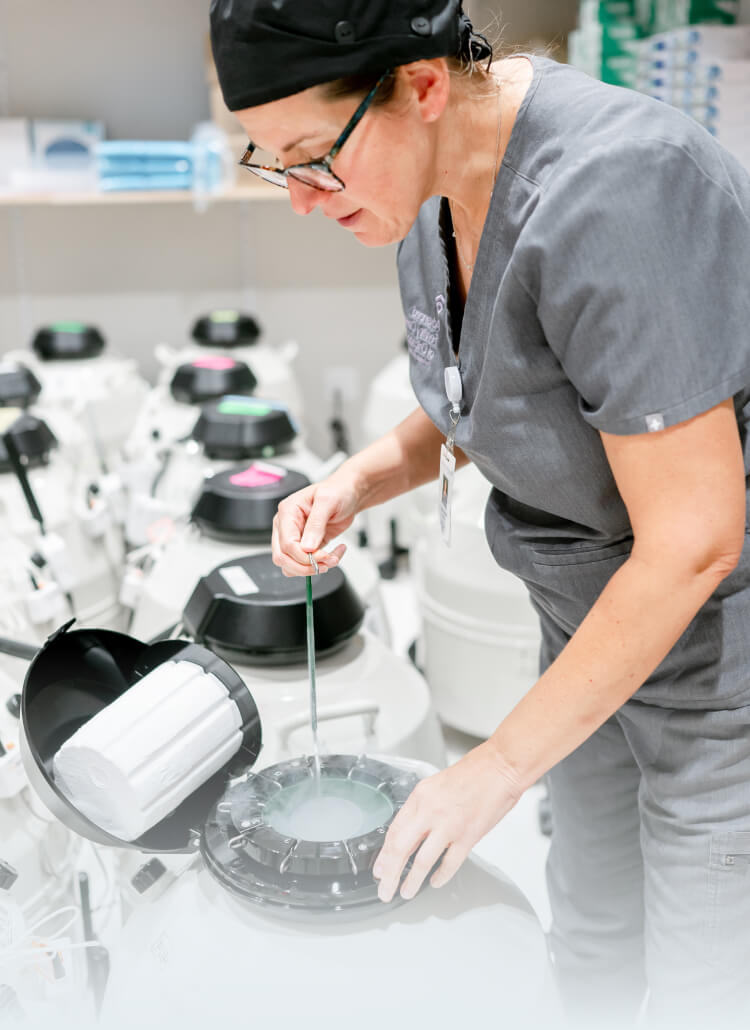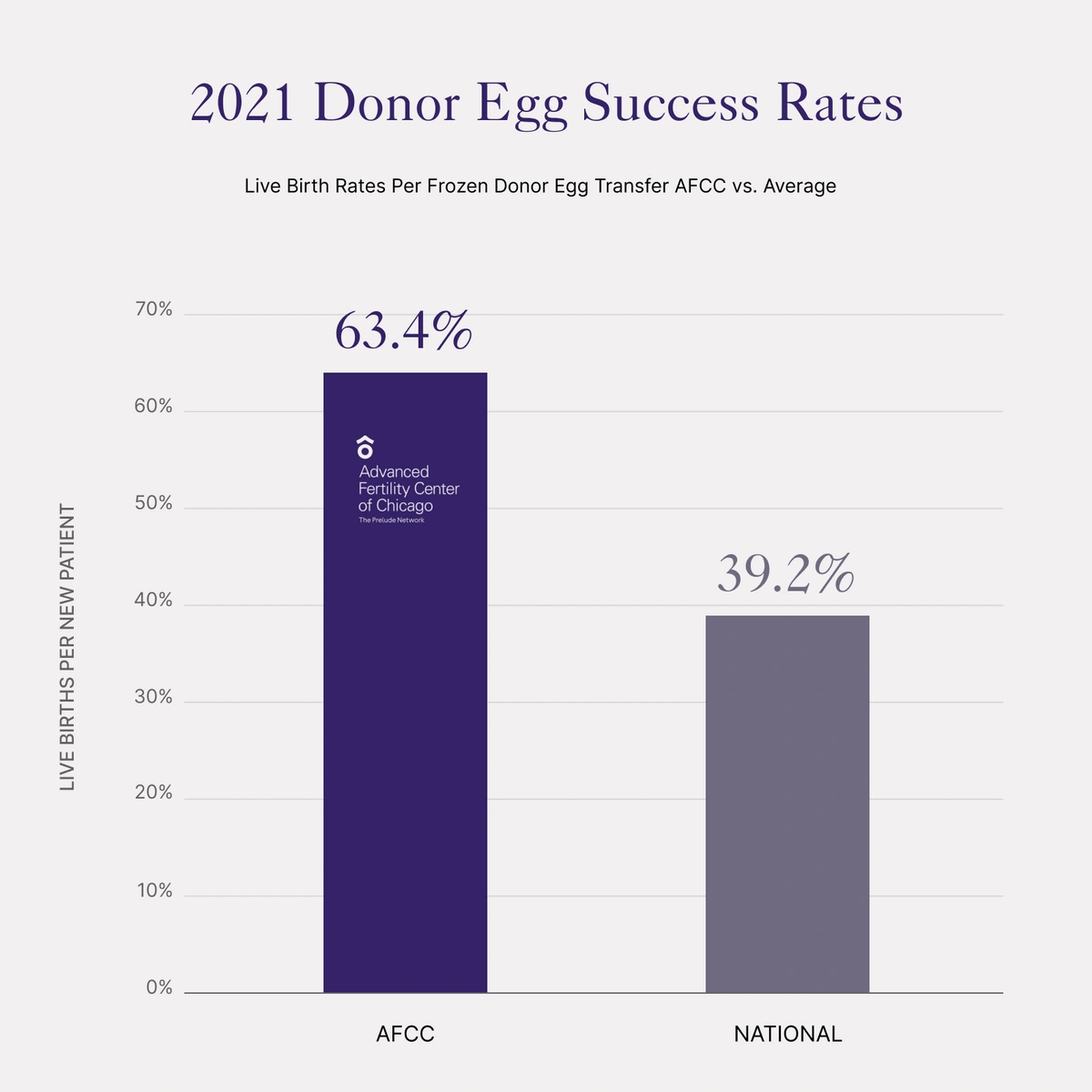IVF Using Frozen Donor Eggs with AFCC
Using cryopreservation technology, patients now have the option of undergoing an egg donor cycle using frozen donor eggs. With frozen donor eggs, the eggs are retrieved from the donor as standard and then frozen through a method known as vitrification, allowing them to be stored for future use. This is the same technology used in fertility preservation and elective egg freezing.
Vitrification is a technique that involves adding cryoprotectants to the eggs and then cooling them at an ultra-rapid rate. The cryoprotectants help prevent the formation of crystals and preserve the egg’s structural integrity. Once frozen, the eggs are stored in our egg bank. When ready, the donor eggs are removed from storage, thawed, fertilized with sperm, and prepared for uterine transfer.
Advanced Fertility Center of Chicago offers both fresh and frozen egg donation cycles. We have provided fresh donor egg treatments since 1997 and frozen donor egg cycles since 2014.
Advantages of Using Frozen Donor Eggs
Egg donation was originally developed using “fresh” eggs. The process involved stimulating the egg donor’s ovaries into producing multiple eggs. The eggs were then retrieved and fertilized using sperm from the male intended parent or a sperm donor. The resulting fresh embryos would then be quickly transferred to the recipient female. Any remaining embryos would be frozen for future use.
Although fresh egg donation is still a popular option for many recipients, more and more patients are turning to frozen donor eggs as an alternative option. According to the Society for Assisted Reproductive Technology (SART), in 2021, there were 3,014 frozen donor egg cycles compared to 1,352 fresh donor egg cycles reported in the USA.
Pros and Cons of Fresh vs. Frozen Donor Eggs
As egg freezing and thawing technologies continue to improve over time, there are some notable advantages when considering frozen donor eggs for embryo creation:
- There is no need to synchronize the egg donor’s and recipient’s menstrual cycles.
- Because ovarian stimulation and retrieval have already been done, you know how many eggs are available before beginning a cycle.
- There can be a shorter time frame from choosing a donor until having embryo transfer when eggs are already frozen.
- Costs per treatment cycle are reduced using frozen donor eggs compared to fresh.
However, the national average for live birth success rates using frozen donor eggs at this time is still somewhat lower than success rates with fresh donor eggs. For example, in 2021, fresh donor egg cycles resulted in a 41.1% live birth rate, versus 39.2% for frozen donor egg cycles. Frozen donor egg cycles tend to have a slightly lower success rate because they typically start with fewer eggs – about 6 on average – compared to fresh donor cycles, which usually begin with around 17 eggs. As a result, the smaller number of eggs can lead to a modest reduction in success rates.
Frozen Donor Egg Success Rates at AFCC
Egg freezing has improved over the past several years through fine-tuning of freezing and thawing protocols. Thawed egg survival and viability are much better than in the past. When these eggs are frozen and thawed at high-quality IVF clinics, we see high pregnancy success rates using frozen donor eggs.
Our 2021 live birth success rate per transfer was 63.4% for frozen donor eggs, versus the US national average of 39.2%.* See our 2021 SART report for more info.
*Note: A comparison of clinic success rates may not be meaningful because patient medical characteristics, treatment approaches, and entrance criteria for ART may vary from clinic to clinic.
Understanding Frozen Donor Egg Success Rates
The success of a frozen egg donor cycle depends on several factors, including:
- The quality of the donor eggs
- The ability of the clinic to perform effective freezing and thawing of the eggs
- The number of eggs thawed
- The number of embryos transferred to the uterus
- The expertise and quality of the IVF program
By maintaining our own inventory of frozen donor eggs and controlling all aspects of the egg freezing process, Advanced Fertility Center of Chicago offers a distinct advantage over fertility programs that only work with third-party egg donor banks. We are also able to maintain excellent quality control by freezing and thawing all eggs in the same laboratory. We also offer partnerships with MyEggBank® for embryo creation with frozen donor eggs.
Frozen Donor Egg Guarantees at AFCC
For your convenience and peace of mind, AFCC offers an embryo development guarantee for any patient using frozen donor eggs to become a parent. If all frozen donor eggs in your lot are thawed and fertilized, we guarantee you will have an embryo available for transfer. If not, which is a rare occurrence in our program, then a free lot of eggs will be provided for another attempt.
Please note that this guarantee does not apply in severe male factor cases because severe impairment of fertilization and/or embryo development could result. Other terms and conditions may apply.
Choose AFCC for Frozen Donor Eggs in Chicago
Ready to take the next step? Our team is here to answer all your questions and concerns so that you can move forward with confidence. Contact Advanced Fertility Center of Chicago today for more information about frozen donor eggs or to schedule a consultation at one of our fertility clinics in Chicago, Downers Grove, Arlington Heights or Gurnee, IL.




